
|
The East India Company established its first factory in the Bengal region in 1633. Several factories were established in Orissa, Bengal and Bihar, and initial;ly they were
all administered from Madras. In 1698, the Company received rights over Calcutta, a fort was constructed there (Fort William), and in 1715 the Bengal Presidency was created.
In 1756, contrary to the instructions of the Nawab of Bangal, Siraj ud-Daulah, the Company engaged in a major fortification of the Fort and eventually the Nawab laid seige to it
and captured it. This was the time when the infamous "Black Hole of Calcutta" incident took place. After the Bengal forces captured the fort, some of the captured prisoners
escaped, and the officer in charge placed the remaining 146 prisoners in a small 14 x 18 foot room overnight. A significant number perished (the number is not known exactly)
from the heat, lack of water and from being trampled in the overcrowded conditions. The Company sent reinforcements commanded by Robert Clive, who recaptured the Fort in
January 1757. As part of the peace treaty signed after this event, the Company secured from the Nawab the right to strike coins at their own mint in the style of the local issues
from Murshidabad.
Coinage began in June 1757 and, within a couple of weeks, the Battle of Plassey marked the beginning of the creation of the British empire in India. After this battle, the Company
acquired property rights over a large part of Bengal and a few years later, in 1764, after the Battle of Buxar, expanded their territory to include much of Bihar and Orissa and even
parts of modern Uttar Pradesh. The basis for the Raj was firmly in place.
|
 |
Bengal Presidency |
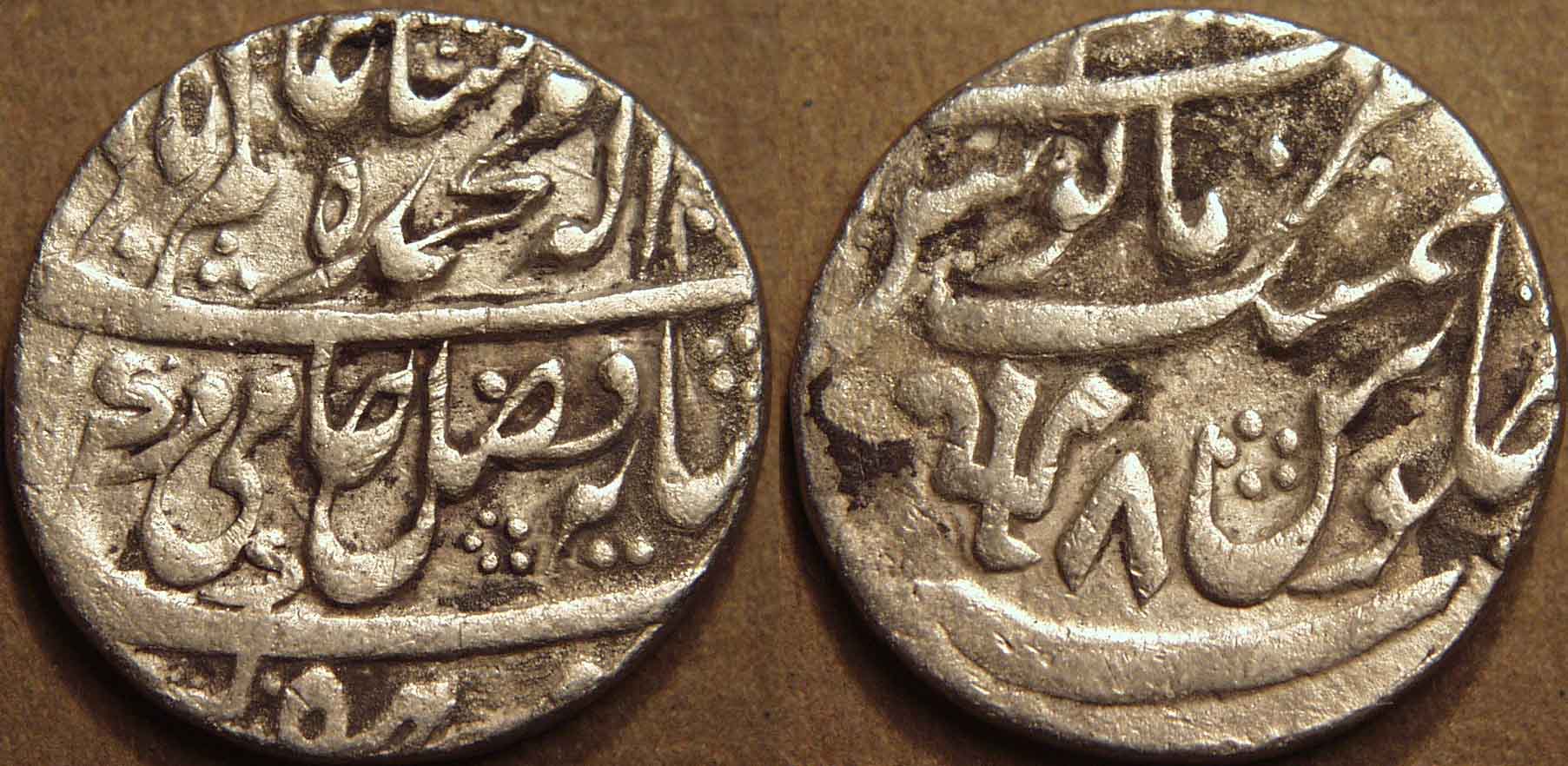
|
Silver rupee in the name of Shah Alam II (1759-1806), Azimabad, RY 8
Weight: 11.45 gm. Diameter: 24 mm Die axis: 9 o'clock
Legend, including mint name Azimabad (Patna)
Legend, including mintmark trident and regnal year 8
Reference: Pridmore 105, KM C814, MNI 1897
|
 |
The British acquired Patna in 1764 after the Battle of Buxar.
|
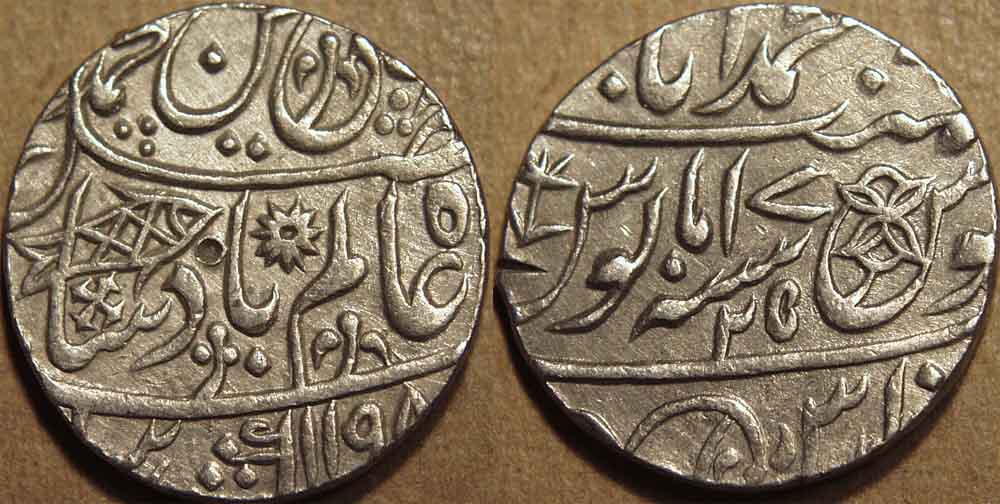
|
Silver rupee in the name of Shah Alam II (1759-1806), Banaras, AH 1198, RY 25
Weight: 11.31 gm. Diameter: 24 mm Die axis: 5 o'clock
Legend, including AH date 1198 (= 1184-85 CE)
Legend, including mint name Muhammadabad Banares,
mintmark fish and double regnal years 17 and 25
Reference: Pridmore ---, KM ---
|
 |
The East India Company acquired the mint at Banares from the Raja of Awadh in 1776, soon after the Battle of Buxar. The coins they
issued from this mint showed a double regnal year, the fixed RY 17 (the RY of the first British issues) and then the progressive RY until the death of Shah Alam II in his RY 49.
Both Pridmore and KM list only the AH date 1197 on coins bearing the RY date of 25. This coin, however, bears the RY 25 along with an AH date of 1198.
|

|
Silver rupee in the name of Shah Alam II (1759-1806), Banaras, AH 1200, RY 27
Weight: 11.17 gm. Diameter: 24 mm Die axis: 5 o'clock
Legend, including AH date 1200 (= 1186-87 CE)
Legend, including mint name Muhammadabad Banares,
mintmark fish and double regnal years 17 and 27
Reference: Pridmore 231, KM 40
|
 |
An important coin that solves an open question. In his listing of these coins, Pridmore has a question mark on the mintmarks, indicating
he was not able to determine the mintmarks on the RY 27, AH 1200 coins. This coin shows the mintmarks clearly, and, in particular, shows that the normal leaf sprig on the
obverse is replaced by a five dot mintmark. Further, the cross that had been appearing under the fish on the coins of the previous few years has disappeared here.
|
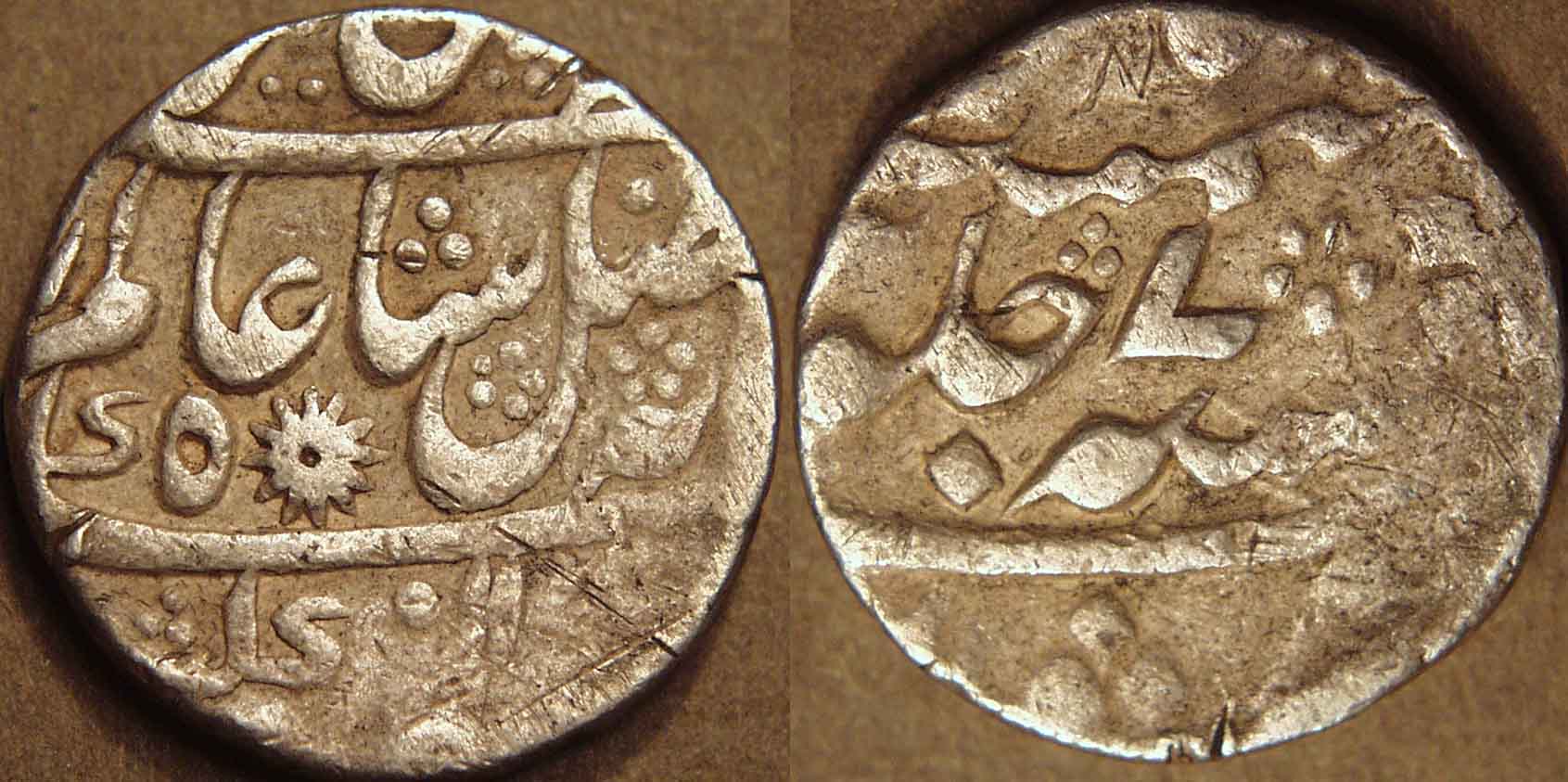
|
Silver rupee in the name of Shah Alam II (1759-1806), Murshidabad, AH 1180, RY 7
Weight: 11.46 gm. Diameter: 22 mm Die axis: 2 o'clock
Legend, including mint name Murshidabad, mint mark star and AH year 1180 (= 1766 CE)
Legend, including regnal year 7
Reference: Pridmore 88, KM 84.1, MNI 1896
|
 |
Shah Alam lost Bengal to the East India Company in 1765 and so issues after that time are British issues. This coin carries a star
mintmark on the obverse (more or less in the center).
|

|
Silver rupee in the name of Shah Alam II (1759-1806), Murshidabad, AH 1182, RY 9
Weight: 11.58 gm. Diameter: 23 mm Die axis: 12 o'clock
Legend, including mint name Murshidabad, mint mark star and AH year 1182 (= 1768-69 CE)
Legend, including regnal year 9
Reference: Pridmore 92, KM 84.1, MNI 1896 var.
|

|
Silver rupee in the name of Shah Alam II (1759-1806), Murshidabad, AH 1185, RY 11
Weight: 11.53 gm. Diameter: 23 mm Die axis: 7 o'clock
Legend, including mint name Murshidabad, mint mark crescent and
AH year 1185 (= 1771-72 CE)
Legend, including regnal year 11
Reference: Pridmore ---, KM ---
|
 |
The later coins from Murshidabad replaced the star mintmark on the obverse with a crescent. This coin seems to be an error coin or a
mule. Shah Alam's regnal year 11 spanned AH 1183-1184 and Pridmore records RY 11 coins with these two AH dates. But this coin has an AH date of 1185! Since AH 1185
was already in Shah Alam's RY 12, this is clearly an error coin or a mule. The celator used an old RY 11 reverse with a current AH 1185 obverse.
|

|
Silver rupee in the name of Shah Alam II (1759-1806), Murshidabad, AH 1195, RY "19"
Weight: 11.61 gm. Diameter: 23.5 mm Die axis: 12 o'clock
Legend, including mint name Murshidabad, mint mark crescent and
AH year 1195 (= 1781-82 CE)
Legend, including regnal year "19"
Reference: Pridmore 139, KM 84.2, MNI 1898 var
|
 |
After 1777 the RY on the Murshidabad coins was frozen at 19, although the AH year did keep changing.
|
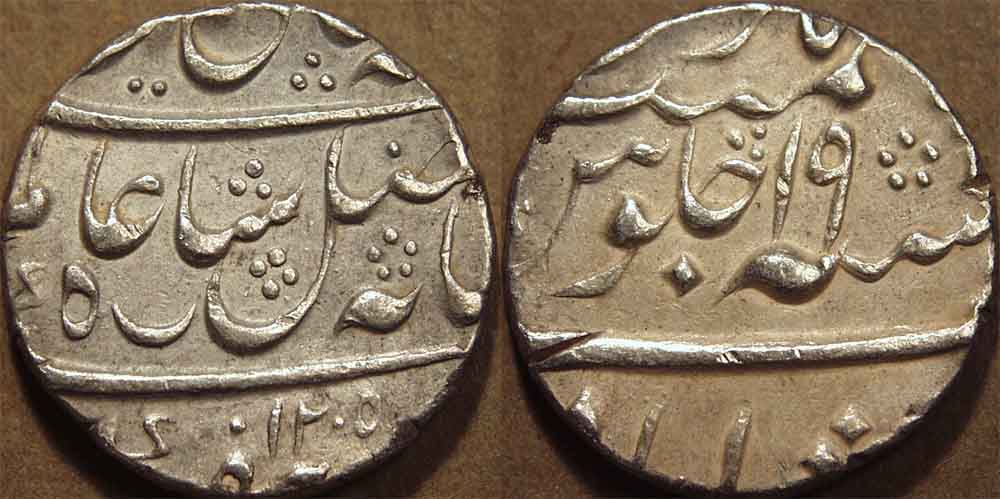
|
Silver rupee in the name of Shah Alam II (1759-1806), Murshidabad, AH 1205, RY "19"
Weight: 11.60 gm. Diameter: 24 mm Die axis: 12 o'clock
Legend, including mint name Murshidabad, mint mark crescent and
AH year 1205 (= 1790-91 CE)
Legend, including regnal year "19"
Reference: Pridmore 147, KM 84.2, MNI 1898
|
 |
This coin has an unusually fine style.
|
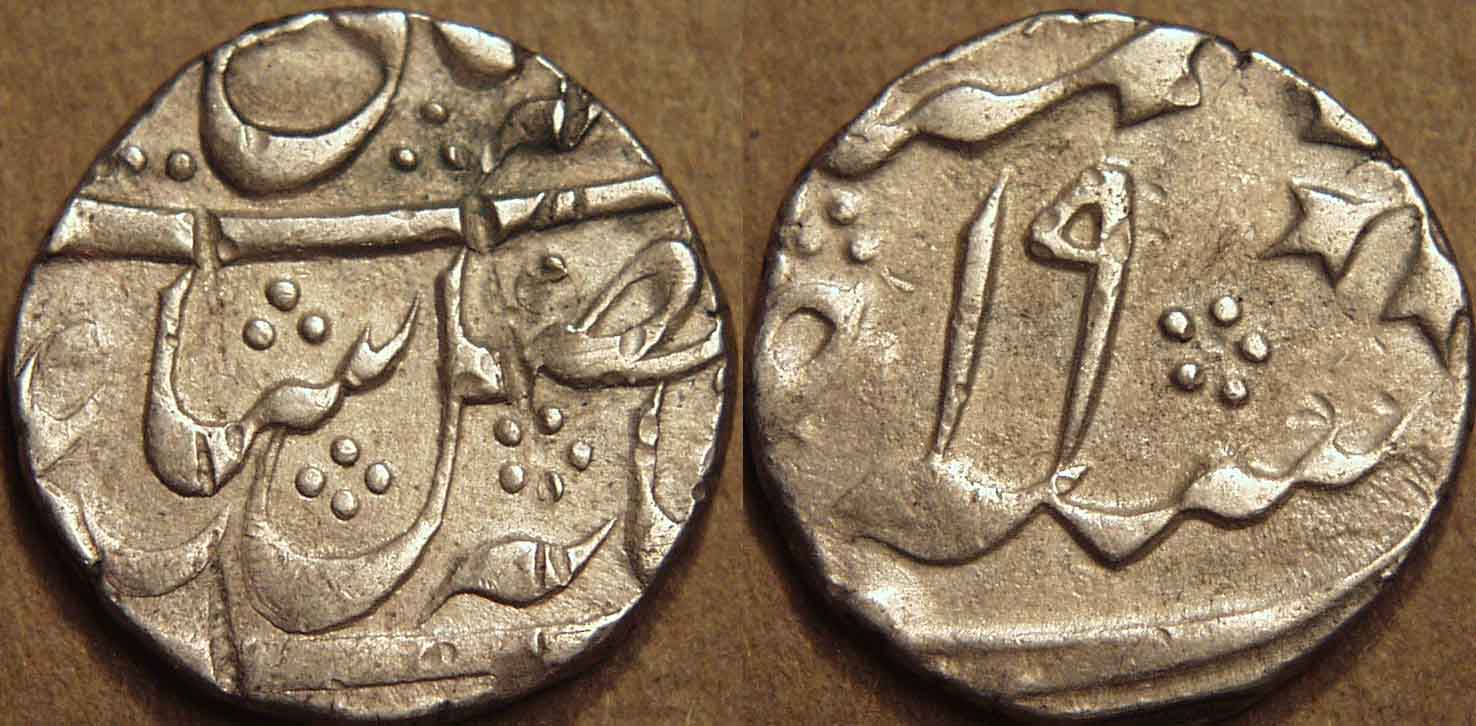
|
Silver 1/2 rupee in the name of Shah Alam II (1759-1806), Murshidabad, RY "19"
Weight: 5.75 gm. Diameter: 20 mm Die axis: 5 o'clock
Legend, including mint name Murshidabad, and mint mark crescent
AH year off flan
Legend, including frozen regnal year "19"
Reference: Pridmore 149, KM 83.3, MNI ---
|
 |
The half rupees are quite rare.
|

|
Silver 1/8 rupee in the name of Shah Alam II (1759-1806), Murshidabad, RY "19"
Weight: 1.43 gm. Diameter: 11 mm Die axis: 9 o'clock
Legend, including mint name Murshidabad, and mint mark crescent
AH year off flan
Legend, including frozen regnal year "19"
Reference: Pridmore 151, KM 81.3, MNI ---
|
 |
The one-eighth rupees are also quite rare.
|
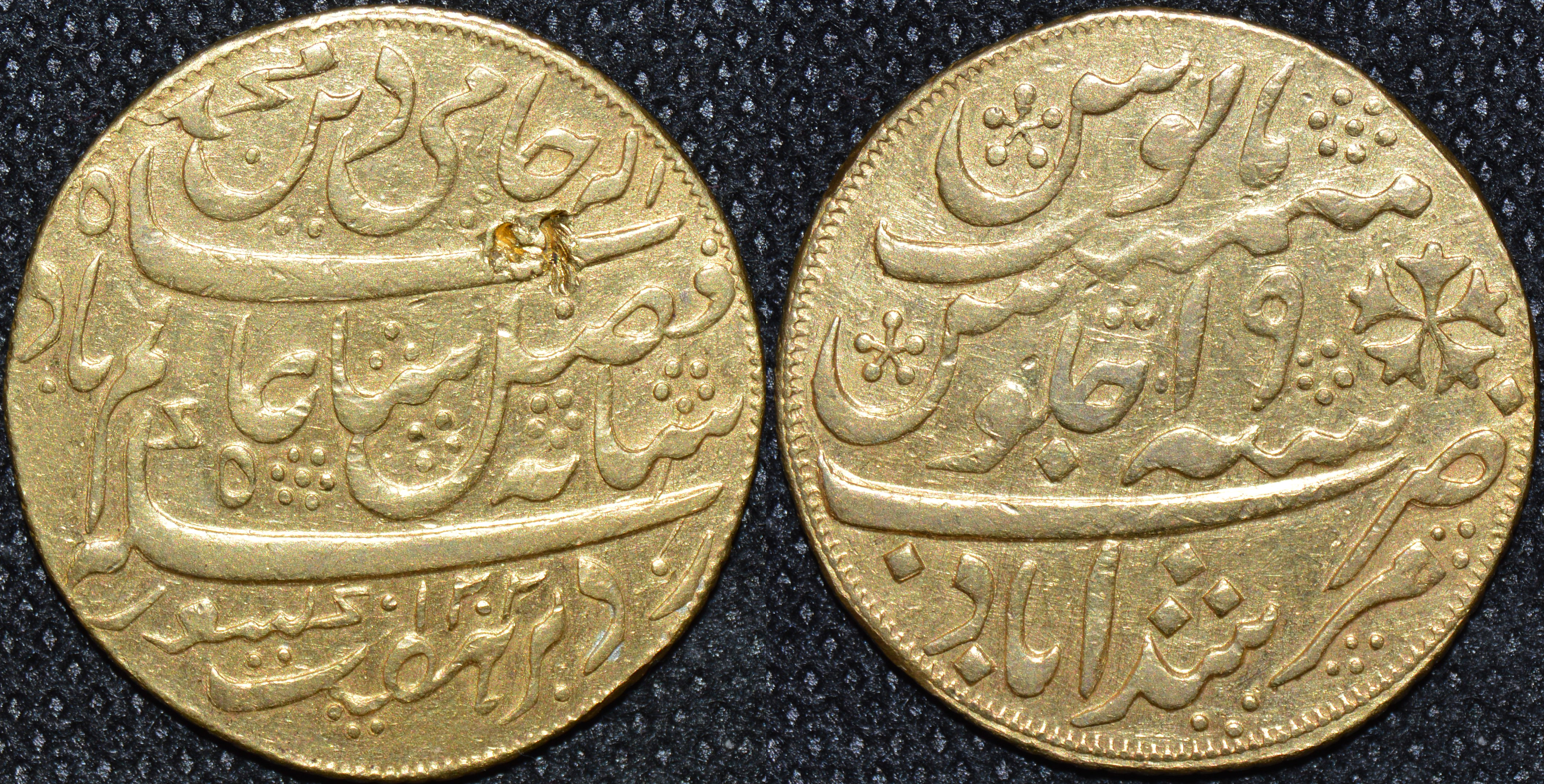
|
Gold mohur in the name of Shah Alam II (1759-1806), Murshidabad, RY "19"
Weight: 12.26 gm. Diameter: 26 mm Die axis: 2 o'clock
Legend, sikka zad bar haft kishwar saya fazl ilah hami ud-din muhammad shah alam badshah,
(Defender of the religion of Muhammad, Shah Alam, Emperor, shadow of the divine favor,
put his stamp on the seven climes), and frozen AH date 1202
Legend, zarb murshidabad sanat 19 julus maimanat manus
(struck at Murshidabad in the 19th year of his reign of tranquil prosperity),
regnal year "19" frozen
Reference: Pridmore 61, KM 102
|
 |
Although the mint name on this coin is Murshidabad, it is actually a Calcutta issue. A new mint was opened there in
1790, where machine struck coins like this one were issued. The lack of any privy marks (see commentary on next coin) proves that this was one of the
initial issues from the mint. The coin has oblique left milling on the edge. Incidentally, there is an error in Pridmore where he lists the diameter of the coin as
30 mm. This coin, and the illustration in Pridmore itself, measure 26 mm.
|

|
Gold mohur in the name of Shah Alam II (1759-1806), Murshidabad, RY "19"
Weight: 12.32 gm. Diameter: 26 mm Die axis: 12 o'clock
Legend, sikka zad bar haft kishwar saya fazl ilah hami ud-din muhammad shah alam badshah,
(Defender of the religion of Muhammad, Shah Alam, Emperor, shadow of the divine favor,
put his stamp on the seven climes), and frozen AH date 1202
Legend, zarb murshidabad sanat 19 julus maimanat manus
(struck at Murshidabad in the 19th year of his reign of tranquil prosperity),
regnal year "19" frozen
Reference: Pridmore 83, KM 103.1 (was 779.2)
|
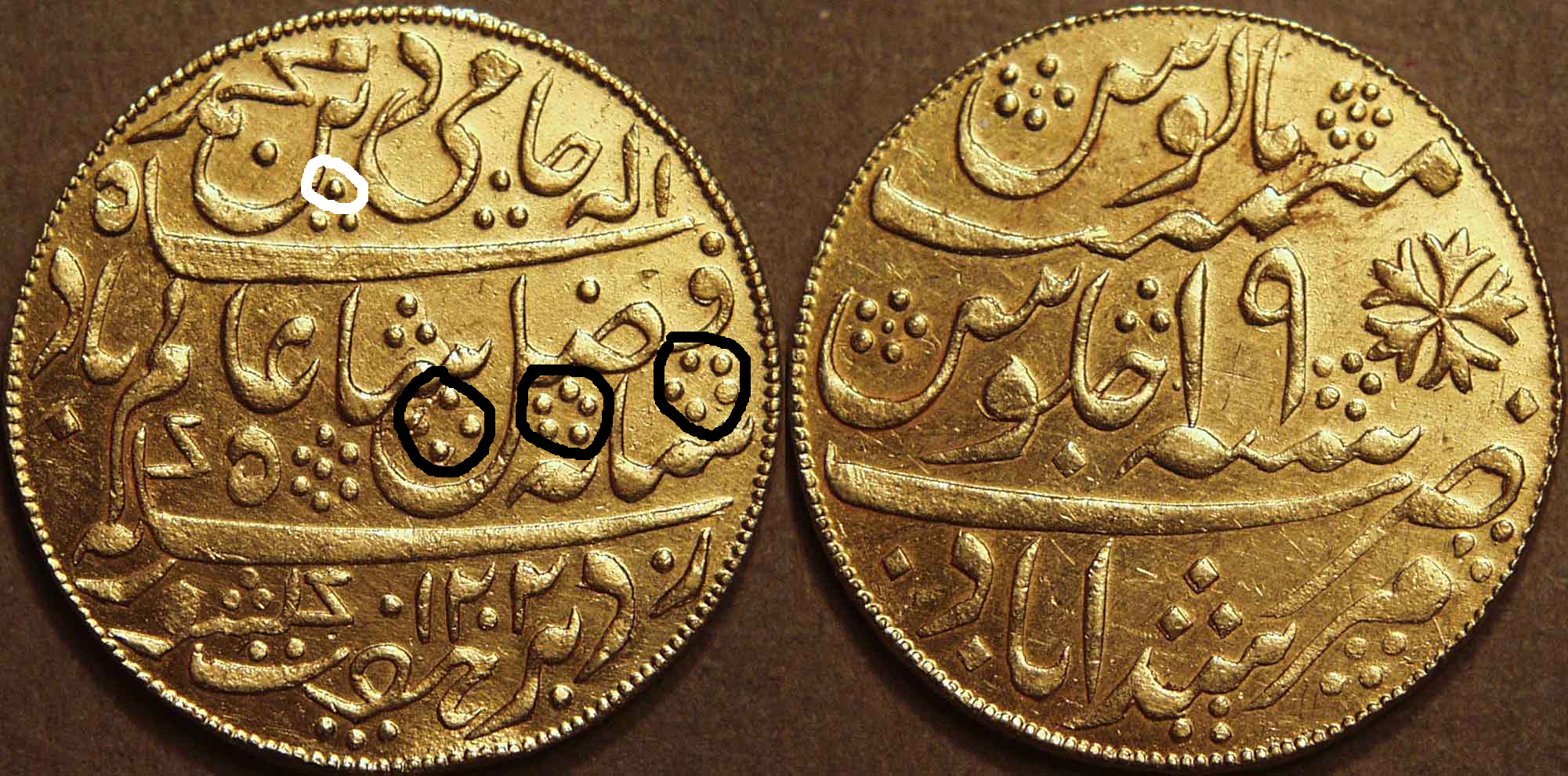
|
In 1793, production of this type was split into four mints. The privy mark (encircled in white) on this coin indicates that
it is a Calcutta issue. Additional dots in the centers of the rosettes circled in black indicated Dacca, Murshidabad and Patna. The coin continues to have oblique
left milling on the edge.
|
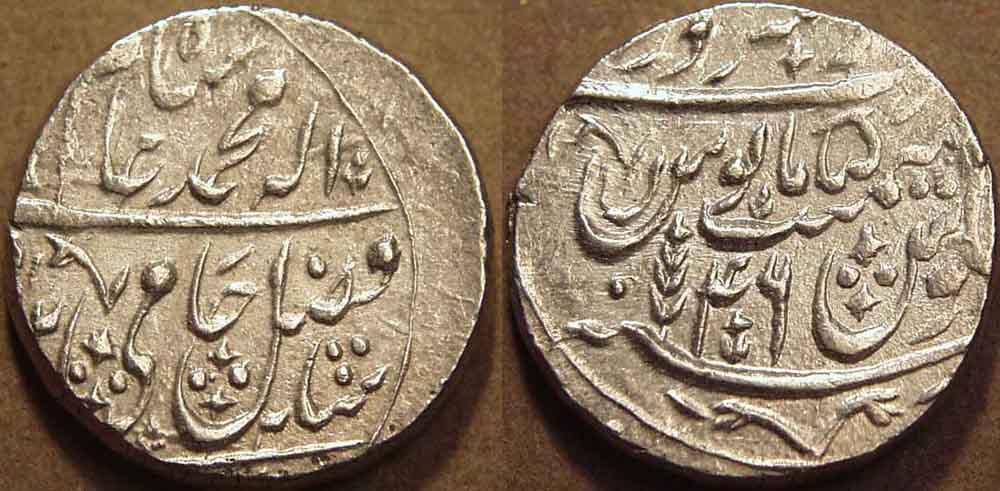
|
Silver rupee in the name of Shah Alam II (1759-1806), Saharanpur, RY 46
Weight: 11.06 gm. Diameter: 21 mm Die axis: 11 o'clock
Legend, AH year (1219) off flan (= 1803-1804 CE)
Legend, including vertical spray, mint name Saharanpur and regnal year 46
Reference: Pridmore ---, KM 693
|
 |
The East India Company acquired the mint at Saharanpur in 1803 and operated the mint for only a couple of years, before shutting it
down in 1805. The coins are quite rare
|
|
|